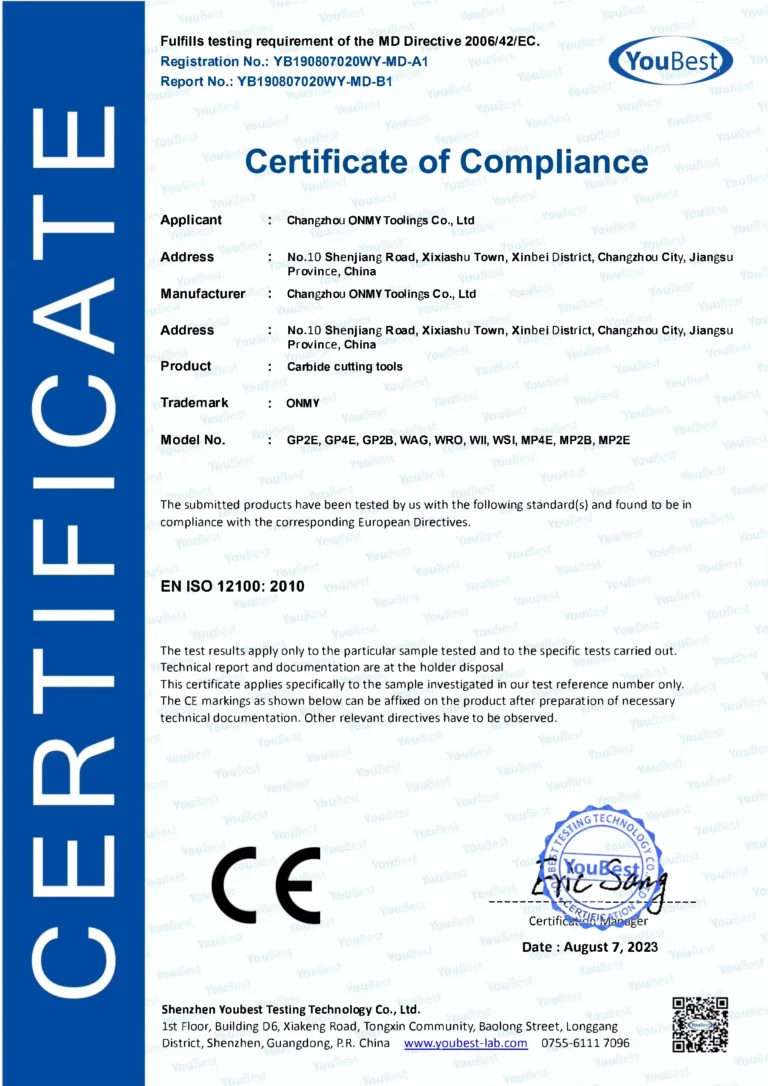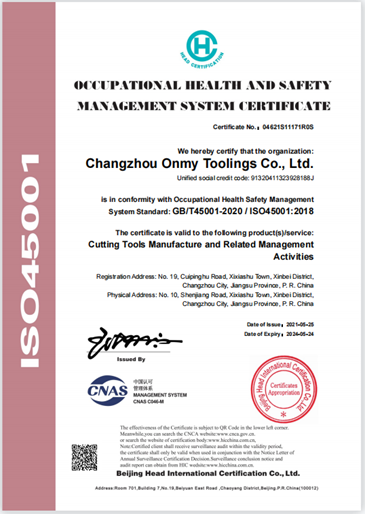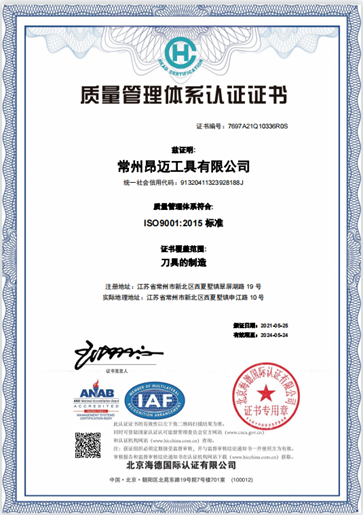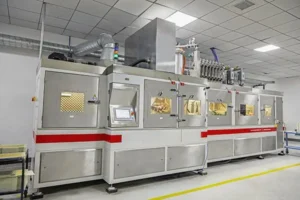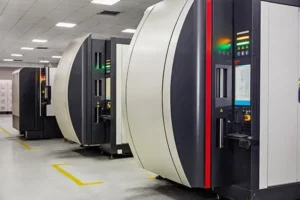Molino final de desacuerdo
Las fábricas finales de desbordamiento se utilizan principalmente para las etapas iniciales del mecanizado, centrándose en la eliminación rápida del material para acercar la pieza de trabajo a su forma final. Sus aplicaciones abarcan diversas industrias y procesos de fabricación.
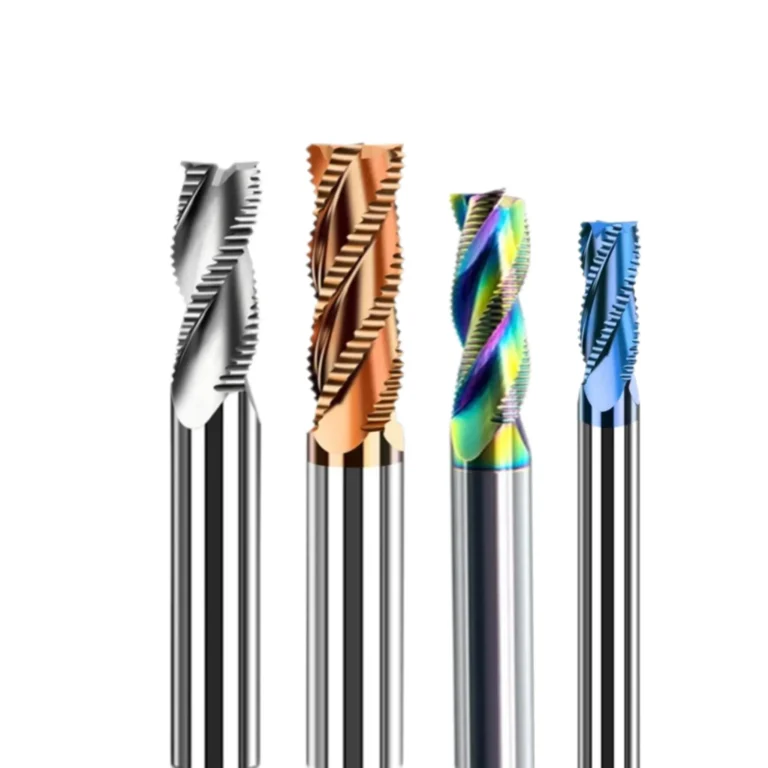
Aplicación del molino final de la fábrica
Aplicaciones comunes:
- La fabricación de moldes y matrices: Creación de cavidades y formas iniciales.
- Industria automotriz: Bloques de mecanismo, piezas de transmisión y otros componentes.
- Aeroespacial: Procesamiento de piezas metálicas grandes para aviones y naves espaciales.
- Mecanizado general: Eliminar el exceso de material de las piezas de trabajo antes de terminar las operaciones.
Operaciones de mecanizado específicas:
- Curvidad: Eliminar grandes cantidades de material rápidamente.
- Ranura: Creación de ranuras o ranuras en la pieza de trabajo.
- Bolsaje: Deshazando bolsillos o cavidades.
- Contorneo: Maltratar la forma básica de una parte.
Características del molino final de Boughing
Geometría del diente
- Diseño de dientes agresivo: Cuenta con dientes más grandes y más espaciados en comparación con las fábricas finales finales.
- Perfil de dientes ondulados o dentados: Romper las chips de manera efectiva, reduciendo las fuerzas de corte y evitando la acumulación de chips.
Diseño de flauta
- Flautas más profundas: Acomode cargas de chips más grandes y mejore la evacuación de chips.
- Diseño de flauta espiral: Mejora la eliminación de chips y reduce las fuerzas de corte.
Material y recubrimiento
- Materiales más duros: Hecho de acero de alta velocidad (HSS) o carburo para soportar condiciones de corte pesado.
- Recubrimientos protectores: A menudo aplicado para mejorar la resistencia al desgaste, la resistencia al calor y la vida útil de la herramienta.
Diseño general
- Mayor diámetro: Permite tasas de eliminación de materiales más altas.
- Longitud de flauta más corta: Proporciona una mayor rigidez y reduce la vibración.

ULTRA MICRO GRAIN CARBIDE& NANO GRAIN CARBIDE
Materiales de sustrato de carburo de grado premium que se extiende la resistencia al desgaste excepcional, lo que hace posible el mecanizado de alta precisión.
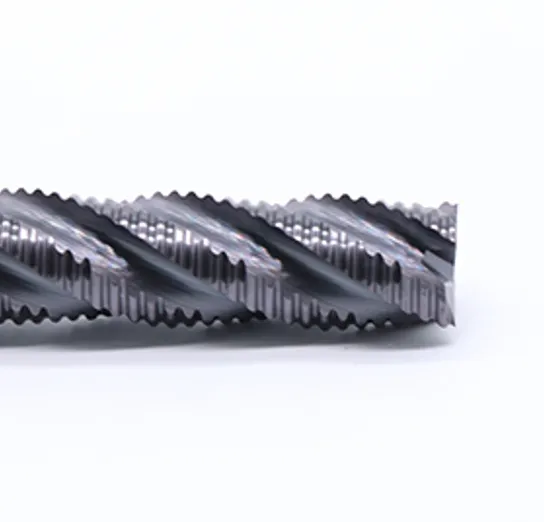
Diseño especializado Ofcorner Gash
- El diseño de flauta único y la protección de esquina superior mejoran tanto la vida útil de la herramienta como la protección contra la falla catastrófica en aplicaciones de alta alimentación.
- Flautas pulidas para un excelente flujo de chips.

SOLICITUD
Adecuado para procesar metales no ferrosos con dureza más suave como aleación de taluminio, aleación de cobre, zincalloy, aleación de magnesio, etc.

Competidor (longitud total de corte: 180m)

OnMy End Mills (Longitud total de corte: 300m)
Catálogo de fábricas de acabado de desacuerdo

La diferencia de herramients de Onmy
¿Qué distingue a nuestra sola flauta de flauta? Es nuestra combinación única de:
Formulaciones de carburo avanzadas
Utilizamos mezclas patentadas de carburo de micro-grano optimizadas para resistencia y resistencia al desgaste.
Geometrías innovadoras
Nuestros diseños de flauta patentados maximizan la evacuación de chips y minimizan las fuerzas de corte.
Recubrimientos de vanguardia
Aplicamos recubrimientos de PVD nano capas que mejoran la resistencia al calor y reducen la fricción.
Rectificación de precisión
Nuestros molinillos CNC de múltiples eje logran tolerancias tan apretadas como ± 0.0005 pulgadas.
Certificación de fábrica
Estas certificaciones no son solo insignias elegantes: son su garantía de calidad consistente y de primer nivel en cada herramienta que producimos. Nuestro proceso de control de calidad incluye una inspección del 100% de las dimensiones críticas y las pruebas avanzadas de resistencia al desgaste para garantizar que cada herramienta cumpla con nuestros exigentes estándares.

Nuestro viaje a la excelencia
Nuestra historia comenzó en un pequeño taller con un gran sueño: crear las mejores fábricas de finales del mundo. Hoy, operamos una instalación de vanguardia de 50,000 pies cuadrados equipados con la última en tecnología de rectificado CNC y sistemas de recubrimiento avanzados. Pero nuestra verdadera fuerza radica en nuestro equipo de ingenieros apasionados y artesanos calificados que invierten su experiencia en cada herramienta que producimos.
¿Por qué conformarse con soluciones estándar cuando puede tener fábricas finales personalizadas adaptadas a sus necesidades específicas? Nuestro equipo interno de investigación y desarrollo está constantemente presionando los límites de lo que es posible en la tecnología de mecanizado. Colaboramos con las principales universidades y socios de la industria para mantenernos a la vanguardia del diseño de la ciencia de materiales y la herramienta de corte.
Don't just take our word for it. Here's what our satisfied customers have to say:
¡Mi feliz cliente!

¡Obtenga su cotización personalizada ahora!
PD ¿Mencionamos que ofrecemos descuentos masivos? ¡Cuanto más ordenes, más ahorrarás!
- Precios inmejorables de fábrica directa: elimine el intermediario y ahorre hasta un 40% en comparación con los precios minoristas. Nuestro eficiente proceso de fabricación nos permite ofrecer una calidad premium a tarifas competitivas.
- Entrega al rayo: con nuestro proceso de producción simplificado, ofrecemos tiempos de respuesta líderes en la industria. ¡Obtenga sus fábricas personalizadas en tan solo 7 días! Mantenemos un gran inventario de tamaños estándar para envío inmediato.
- Servicio personalizado: nuestro equipo de ingenieros expertos está listo para ayudarlo a encontrar la solución perfecta para sus desafíos de mecanizado únicos. Ofrecemos consultas gratuitas para analizar sus necesidades específicas y recomendar las especificaciones de herramienta ideales.
Preguntas frecuentes
Una fábrica final de desacuerdo se usa principalmente para eliminar rápidamente grandes cantidades de material de una pieza de trabajo. Está diseñado para la eficiencia en las etapas iniciales del mecanizado, donde el objetivo es dar forma a la pieza de trabajo en una aproximación aproximada del producto final.
Sí, las fábricas finales de desbordamiento se pueden usar para el mecanizado de alta velocidad (HSM), pero con algunas consideraciones.
Mientras que tradicionalmente está diseñado para la eliminación de materiales pesados a velocidades más bajas, los avances en la tecnología de herramientas han producido accesorios de fábricas finales específicamente optimizadas para HSM. Estas herramientas cuentan:
- Geometría de dientes optimizado: Diseñado para manejar velocidades de corte más altas y producir chips más pequeños.
- Evacuación mejorada de chips: Eliminando eficientemente chips a altas velocidades de alimentación.
- Recubrimientos avanzados: Mejorar la vida y el rendimiento de la herramienta en condiciones de HSM.
Sin embargo, es crucial seleccionar la fábrica final correcta para su aplicación HSM específica. Factores como el material, las capacidades de la máquina y el acabado superficial deseado influirán en la elección de la herramienta.
Una fábrica de acabado es una herramienta de corte diseñada para eliminar rápidamente grandes cantidades de material de una pieza de trabajo. Está diseñado específicamente para la eficiencia en las etapas iniciales del mecanizado, donde el objetivo es dar forma a la pieza de trabajo en una aproximación aproximada del producto final.
Características clave de una fábrica de acabado:
- Geometría agresiva del diente: Diseñado para romper las chips de manera efectiva y reducir las fuerzas de corte.
- Cargas de chips más grandes: Capaz de manejar cargas de corte más pesadas en comparación con las fábricas finales de acabado.
- Acabado superficial más áspero: Produce una superficie menos refinada en comparación con las fábricas finales de acabado.
Molino final de desacuerdo
- Objetivo: Elimina rápidamente grandes cantidades de material de una pieza de trabajo.
- Diseño: Geometría dental agresiva, cargas de chips más grandes, velocidades de alimentación más rápidas.
- Resultado: Acabado superficial rugoso.
Molino final final
- Objetivo: Logra un acabado superficial liso en la pieza de trabajo.
- Diseño: Dientes más pequeños y más nítidos, cargas de chips más bajas, velocidades de alimentación más lentas.
- Resultado: Acabado superficial liso.
En esencia:
- Broying End Mills se utilizan para acercar la pieza de trabajo a sus dimensiones finales.
- Finales finales fábricas se utilizan para lograr la calidad y tolerancias de la superficie deseadas.
Beneficios de usar molinos finales de agravio:
- Ahorros de tiempo: La eliminación rápida del material reduce el tiempo de mecanizado.
- Vida de la herramienta: Menos desgaste en la herramienta de corte en comparación con el uso de una fábrica de acabado para desbastar.
- Rentable: Costos de eliminación de material optimizado.
- Mejor confiabilidad del proceso: Resultados consistentes debido al diseño de herramientas especializadas.
Si bien hay una inversión inicial en la compra de molinos finales, los beneficios a largo plazo a menudo superan el costo. Al usar la herramienta adecuada para el trabajo, puede mejorar la eficiencia general de mecanizado y reducir los costos de producción.

